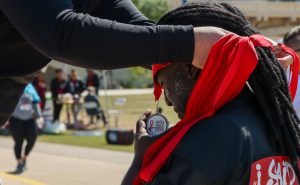- Slug: BC-CNS-AIDS Walk. 1,300 words.
- Photos available (thumbnails, captions below).
By Brenna Gauchat
Cronkite News
TEMPE – Kenyon Belyeu was handing out leaflets and condoms at the Aunt Rita’s Paint the Town Red AIDS Walk Arizona & 5K Run, when he talked candidly about his own HIV diagnosis – a discovery he made only because he was being treated for substance use disorder.
“Terros came to do HIV testing and STI (sexually transmitted infection) testing,” said Belyeu, a Terros Health program supervisor. “I found out nine years ago that I was HIV positive and if I never went to rehab or if I never got tested, I would never know my status.”
Terros Health, an Arizona-based health care company, was just one of the many partner organizations involved in the AIDS Walk Arizona & 5K Run on April 6. Aunt Rita’s Foundation, which began in 1988 with the purpose of “filling in the gaps” in community HIV care, was the organizer of this year’s event. The foundation supports HIV prevention and treatment programs with grants to groups like Terros Health that may not have the budget to cover its wide range of HIV-related services.
In Tempe Beach Park’s grassy field where Belyeu staffed the Terros Health table, runners stretched their legs and helped each other pin bibs to the front of dry fit shirts as upbeat pop music played loudly in the background
“It’s so important because it’s 2024 and there’s still stigma,” Belyeu said about why he attended the event that morning. “We have to be self-conscious and we have to know our status.”
Kicking off the event, Tempe Mayor Corey Woods took the stage and thanked the foundation, its partners and attendees for uniting under a common cause.
“In a world that can often … feel divided and disconnected, events like this remind us of the power that we hold when we come together as a community,” Woods said.
“This walk is not just about walking, though. It’s about walking with purpose,” he said. “It’s about honoring lives lost, but also making sure that we celebrate the progress that we’ve made.”
Correcting misinformation
The evolution in HIV treatment and education since the United States’ AIDS epidemic began in the 1980s has been life saving. Testing and treatment are now more widely available than ever, but misinformation often presents a barrier to some who need this care.
“Some people think it’s transmitted by saliva. Some people think you can get it from mosquito bites,” Andrea Leuser, an HIV nurse navigator at Neighborhood Outreach Access to Health (NOAH), said about the importance of demystifying HIV transmission. “A lot of people just don’t know how HIV is transmitted.”
In reality, HIV can be transmitted by sexual contact, sharing needles or during pregnancy, birth and breastfeeding, according to the Centers for Disease Control and Prevention. The only bodily fluids that can transmit HIV include blood, semen, pre-seminal fluid, rectal fluids, vaginal fluids and breast milk.
HIV, the human immunodeficiency virus, attacks cells that help fight infection and makes a person more vulnerable to other infections and diseases. It can lead to the deadly disease of AIDS if untreated.
HIV treatment now includes antiretroviral therapy (ART) and involves taking medication prescribed by a health professional. ART is taken in pill form initially and may be switched to a longer-lasting shot form. This treatment reduces the amount of HIV in the body so it becomes undetectable, thus becoming untransmittable.
“It’s not a cure for HIV, but it helps. It’s manageable,” Leuser said. “So you’re undetectable, you can’t transmit it and the virus isn’t replicating.”
Kate Thomas, senior health educator at Maricopa County Public Health, helps implement the county’s Ending the HIV Epidemic plan, which is supported with federal funding. Thomas is also the co-creator of the Positively You! media campaign that emphasizes a “U = U,” mindset which means “undetectable equals untransmittable.”
“What we’re doing with Positively You! is really promoting the ‘u equals u,’ undetectable equals untransmittable concept. Treatment as prevention,” Thomas said. “When a person with HIV takes their medication every day as prescribed, they can suppress the amount of virus in their body to undetectable levels, meaning they cannot pass on HIV to their sexual partners.”
Addressing disparities and linking to care
Developed by the White House Office of National AIDS Policy and published in December 2021, the National HIV/AIDS Strategy for the United States (2022-2025) outlines a governmental commitment to end the HIV epidemic in the country by 2030.
The strategy zeroes in on where efforts are most needed: “Although HIV remains a threat in every part of the United States, certain populations — and parts of the country — bear most of the burden, signaling where HIV prevention, care, and treatment efforts must be focused.”
The strategy identifies disparities according to data provided by the CDC. Those who identify as gay, bisexual, or a man who has sex with men, especially among the Black, Latino and American Indian/Alaska Native community, may have a higher risk of contracting the virus.
Communities that also may be at a higher risk are Black women, transgender women, youth and people who inject drugs. These disparities exemplify the need for proper education and accessible testing in places like homeless shelters, rehabilitation centers and schools.
“We want to make sure that the education is getting out there, that we’re designing programs that are meeting the needs of folks where they’re at and are designed to help these specific groups that may be facing higher rates of transmission in their communities,” Thomas said.
When Belyeu learned he was HIV-positive in a rehabilitation center nine years ago, he said it probably took him a month to see a doctor and two months to start treatment. Now, Arizona offers Rapid START – for State of Arizona Rapid Treatment – a system where patients can see a doctor within 72 hours of a positive HIV test result and start treatment immediately afterwards.
“It’s not like it was 40 years ago, it’s not a death sentence,” Belyeu said. “Because of the medications that are out there, people live into their 80s and 90s now.”
Ending the stigma
Kimberly Jordan, representing Queer Center and the Trans Spectrum of Arizona at the event, has been involved in HIV activism and advocacy since 1995 after witnessing many of her friends die from the virus. Jordan said eliminating the stigma, in all communities, is vital if real change is to be enacted.
“In the Black community, it’s still tough,” Jordan said. “I just did a panel at a church, a Black church, here in Phoenix. And the snickers and the laughs and the disrespect that were coming toward the speakers were really disheartening.”
Although data shows HIV disproportionately affects some communities, the notion that only these communities are able to contract the virus is false.
“A lot of people think that it’s people of color that get HIV. Or only gay people get HIV,” Belyeu said. “But really everyone can get HIV. It doesn’t matter what color you are, what creed you are, what sexual orientation. You can catch HIV.”
“I believe everybody should get tested as frequently as possible,” said Grace Ashu, the regional director for CAN Community Health, a nonprofit that provides HIV medical care. “On average, if you do have multiple partners or you have a single partner, it’s most common to get tested at least once a month, if not every 90 days.”
The two most common pieces of advice from every table at the event: Talk about it and get tested.
“We want people to get out there, to talk about it,” Thomas said. “The more we talk about it, the less secretive it is, the less stigma there is and the closer we can get to ending the epidemic.”








